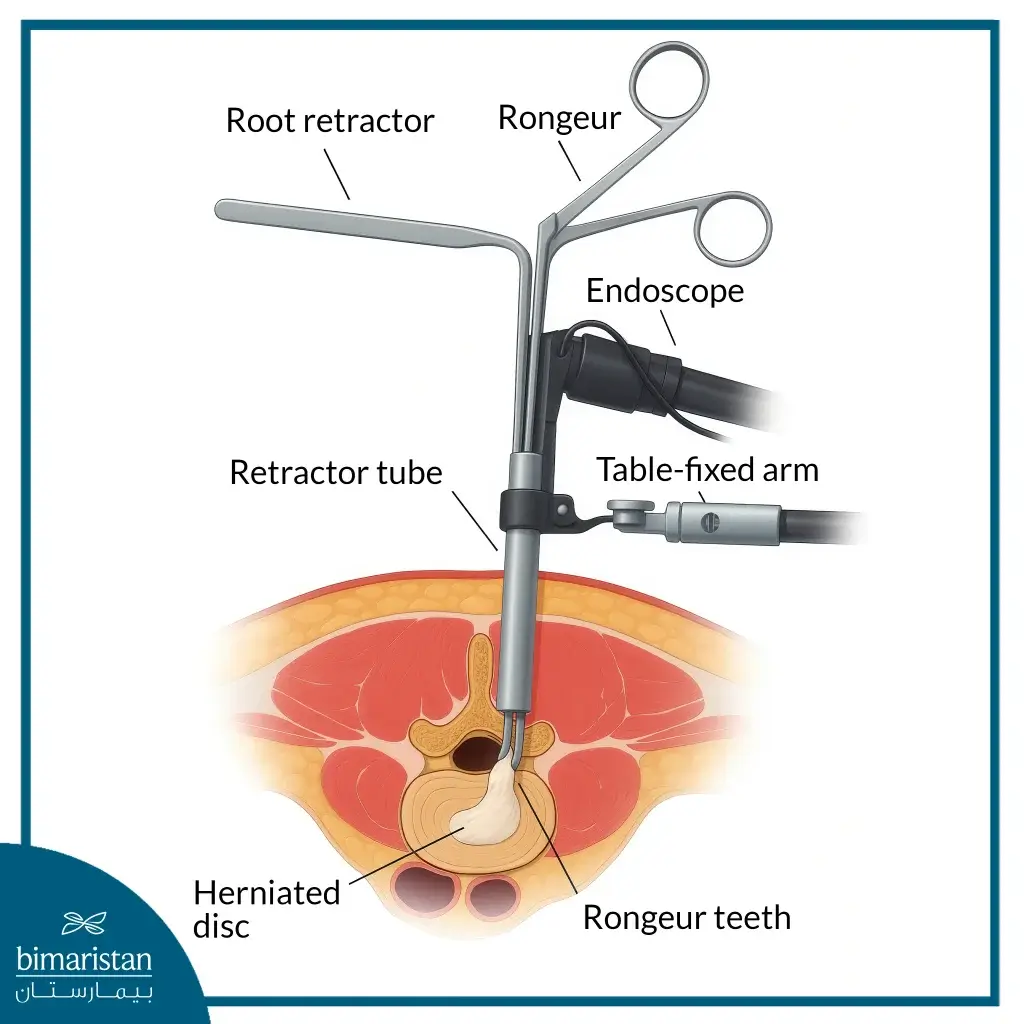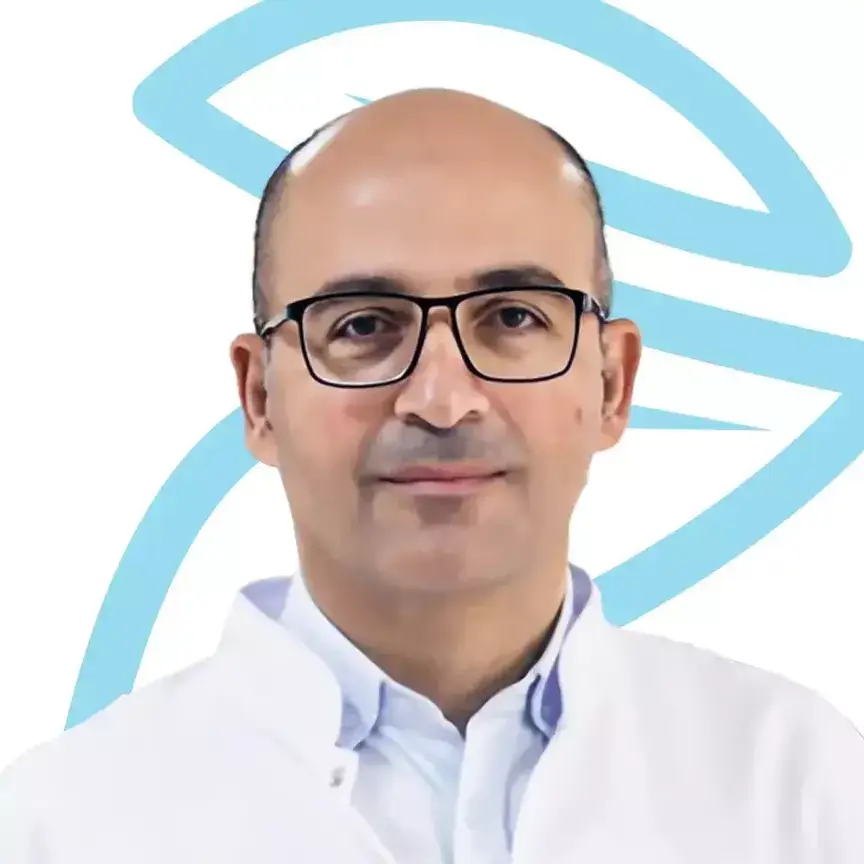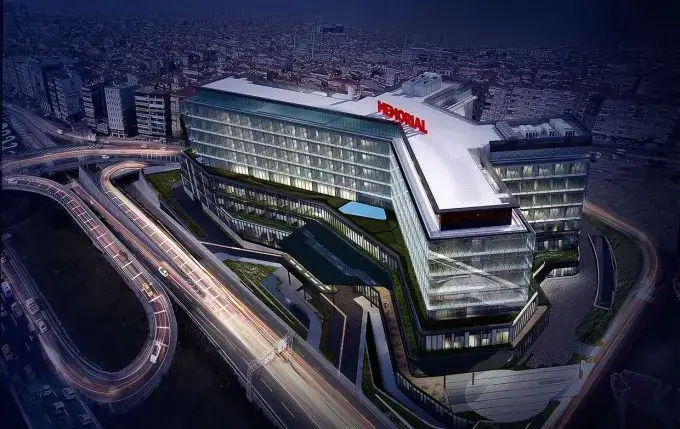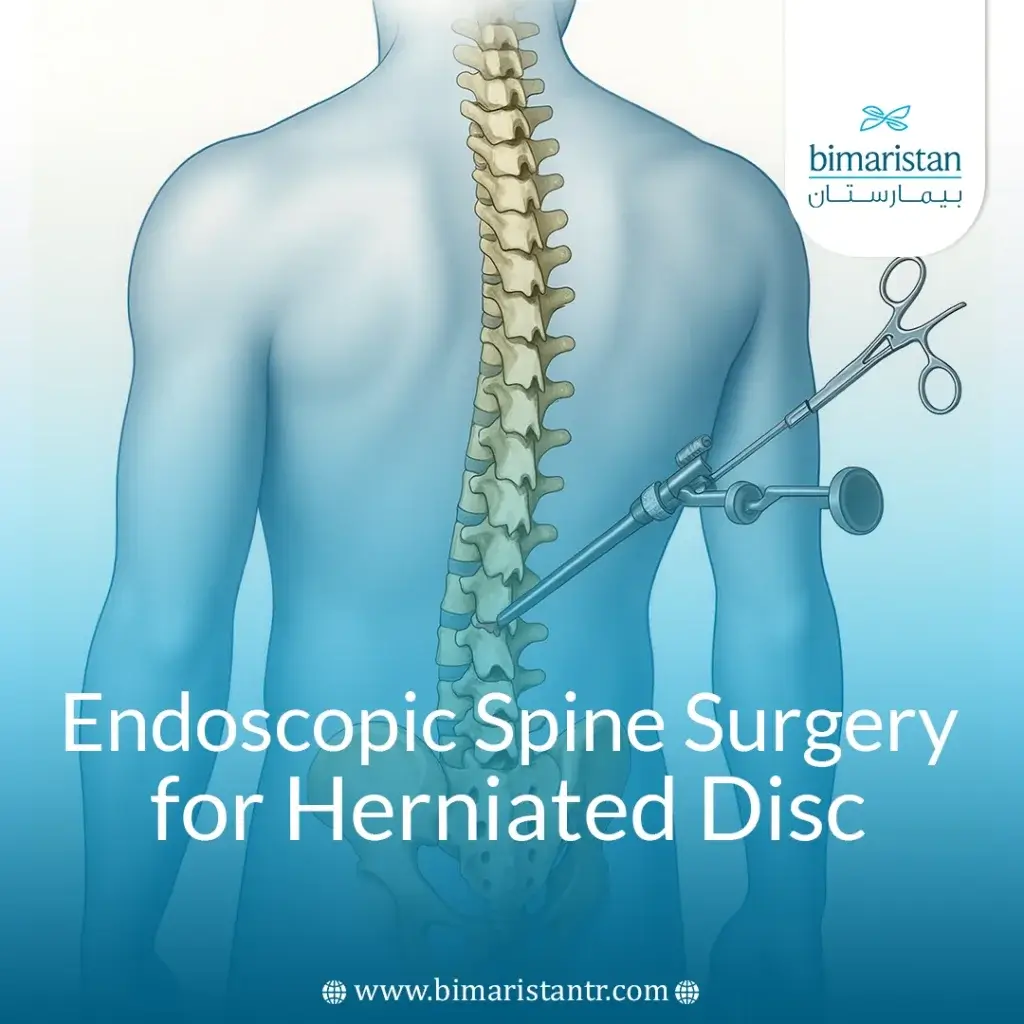With the evolution of spine surgery techniques, endoscopic spine surgery for herniated disc has emerged as one of the most prominent treatment methods. Today, it has become a standard option in advanced centers worldwide due to its high precision, minimally invasive approach, and rapid recovery. While herniated disc treatment once required complex procedures, it is now safer and more comfortable.
What is a herniated disc?
A herniated disc is a condition that affects one of the intervertebral discs between the vertebrae of the spine. This disc consists of a soft gelatinous nucleus (nucleus pulposus) coated with a fibrous outer layer (annulus fibrosus). When the outer layer is torn or weakened, the nucleus may push outward, resulting in pressure on nearby nerves and leading to pain, numbness, or muscle weakness. Slipped discs most often occur in the lumbar spine (lower back) but less commonly in the cervical or thoracic spine.
Common causes of herniated discs
- Aging and deterioration of the disks over time
- Repetitive movements or incorrectly lifting heavy weights
- obesity
- Sitting for long periods of time with poor posture
- Weak back or abdominal muscles
- Genetic predisposition or family history
Common symptoms of a herniated disc
- Localized or radiating pain in the back or legs (sciatica)
- Numbness or tingling in the limbs
- Weakness in the muscles associated with the pinched nerve
- Difficulty walking or standing for long periods of time
- Worsening pain when coughing or sneezing
When is endoscopic spine surgery for herniated disc recommended?
In advanced cases where the disc has completely eroded or the MRI shows a complete loss of height and function, an alternative procedure may be recommended, such as artificial disc surgery, which aims to restore the normal movement of the vertebrae, as endoscopic spine surgery for herniated discs is one of the most advanced and effective options, and is recommended in the following cases: endoscopic spine surgery for herniated discs:
- Failure of conservative or pharmacologic treatments: When anti-inflammatory medications, rest, or physical therapy do not give significant results within 6-12 weeks, endoscopic intervention becomes the most appropriate option to relieve this nerve compression.
- Persistent or worsening neurological symptoms: Numbness, muscle weakness, or diffuse pain in the leg or arm indicates that there is significant pressure from the slipped cartilage on the spinal nerves.
- The impact of pain on quality of life: When pain prevents the patient from sleeping or performing normal daily activities despite non-surgical treatment attempts.
- Suitability based on medical evaluation: The doctor analyzes the results of the MRI and neurological tests to determine the patient’s suitability and readiness for the procedure.
- It is preferable to traditional surgery in some cases: Endoscopic herniated disc surgery is less invasive than traditional surgery, does not require large incisions, and minimizes blood loss and recovery time compared to open surgery.
Endoscopic spine surgery for herniated discs: Steps to treat the condition
This procedure removes the part of the cartilage causing the nerve compression using a microscope through a very small incision (less than 1 cm), to minimize surgical intervention and speed up recovery:
- Preparation and anesthesia: The case is thoroughly evaluated through clinical examination and MRI images, where the doctor decides on the type of anesthesia (general or local anesthesia with mild sedation) and prevents the patient from eating for several hours before the procedure.
- Skin incision and endoscope insertion: A very small skin incision (often less than 1 cm) is made through which a thin endoscope equipped with a high-resolution camera and a fine working channel is inserted. The endoscope is used directly to access the affected disc area without having to open the surrounding tissues extensively. The instrument is precisely guided using fluoroscopy and direct imaging through the scope, allowing a clear view of the location of the slipped disc and avoiding damage to neighboring tissues.
- Accessing the slipped disk: The surgeon reaches the area of the damaged disc without opening wide or removing unnecessary tissue, using direct radiography to achieve the required precision.
- Removal of the compressed cartilage fragment: The displaced segment is carefully removed and may use delicate instruments such as forceps or specialized suction devices, and in some cases, small surgical forceps or lasers may be used, depending on the technique used.
- Verification of nerve release and closure of the incision: After removing the compressed portion, the nerve is checked for complete release, the tube or scope is removed, and the incision is closed with a bandage only without deep sutures.
- Post-operative follow-up: The patient is transferred to the recovery room for observation and may be allowed to leave the same day or stay overnight, depending on the state of health. Healthy habits and a conscious lifestyle are advised to avoid recurrence of slippage.
Types of endoscopes used
- Full Endoscope (Full Endoscopic Discectomy): It is done through a direct incision of the disc under the view of a camera.
- Micro-endoscopic Discectomy (MED): Using a smaller scope but with optical magnification (microscope).
- Transforaminal Endoscopic Lumbar Discectomy (TELD): Through a lateral incision, common in cases of lateral slippage.

Recovery and post-procedure
After arthroscopic herniated disc surgery, the patient is transferred to the recovery room for a short observation, and most patients are allowed to go home the same day. The patient is advised to start light walking hours after the operation and avoid weight-bearing or torsional movements for at least two weeks. Office work can be returned to within days, while strenuous physical activities are postponed until after the doctor’s evaluation.
Follow-up appointments usually include visits within the first week and then after 4-6 weeks, with periodic check-ups as the condition progresses. Maintaining a healthy back posture while sitting or sleeping and practicing supervised strengthening exercises when needed will help reduce the risk of recurrence and promote nerve healing.
Advantages of Endoscopic Therapy
Endoscopic spine surgery for herniated discs is an excellent option and offers many benefits over traditional surgery:
- Small skin incision: Performed through a small incision, often less than 1 cm, which significantly reduces tissue damage and surgical scarring.
- Less blood loss: Due to minimal tissue interference, there is less need for a blood transfusion during or after the procedure.
- Pain relief after surgery: Pain from the incision and muscle compression is limited, reducing the need for strong painkillers.
- Faster recovery: Patients can be discharged the same day in many cases and return to normal activity within days to a few weeks instead of months.
- Maintains the stability of the vertebrae: There is no bone removal or change in the structure of the spine, which maintains the natural stability of the vertebrae.
- Fewer complications: Significantly lower risk of infection or adhesions compared to open surgery.
- Direct visualization: The endoscope gives the doctor a high-definition view of the disc area, allowing us to precisely target the affected tissue without affecting the neural periphery.
Comparing endoscopic therapy with other treatments
| Criterion | Endoscopic | Open Surgery | Conservative treatment (pharmacological and physical) |
|---|---|---|---|
| Type of overlap | Minimally invasive | Major surgery | non-invasive |
| Surgical incision | ~0.5 – 1 cm | 3 – 6 cm or more | There is no |
| Pain after treatment | Very limited | average | May persist or improve slowly |
| Recovery period | Days – 2 weeks | Weeks – Months | undefined |
| Risk of infection | Very low | Relatively higher | There is no |
| Accurate cartilage targeting | High (under direct endoscopic guidance) | Medium | Indirect |
| Use of painkillers | limited | More common | Sometimes continuous |
Why do so many people prefer to have endoscopic treatment in Turkey?
Turkey is one of the world’s most prominent medical destinations for endoscopic herniated disc surgery, thanks to integrated advantages that combine quality and affordability, as well as internationally accredited hospitals that provide world-class services, supervised by specialized doctors with expertise in precise techniques such as spinal endoscopy, among the most important of these advantages:
- Relatively low cost compared to European and Gulf countries while maintaining the highest quality standards
- Advanced medical devices and new technologies (such as Full Endoscopic Discectomy and TESSYS)
- Short waiting period allowing for immediate treatment without delay
- Comprehensive care including translation, transportation, and medical accommodation
- A relaxing tourist environment that aids mental and physical recovery after the procedure
- Choosing Turkey for arthroscopic herniated disc treatment is not only about cost, but also about the quality of the overall medical care
With recent advances in spine technologies, endoscopic spine surgery for herniated discs has become a safe and effective option for patients who have not responded adequately to conservative treatment. This technique offers high precision, a small incision, less pain, and a quick recovery compared to traditional surgery. Thanks to its availability in internationally accredited medical centers such as those in Turkey, patients can access high-quality and affordable care. Therefore, endoscopic spine surgery for herniated discs is one of the leading solutions, especially when applied at the right time under the supervision of a specialized medical team.
Sources:
- Mummaneni, P. V., & Pan, J. (2023). Minimally Invasive Spine Surgery. In J. A. Atkinson, T. A. Loftus, & J. F. Dydyk (Eds.), StatPearls. StatPearls Publishing.
- MedlinePlus. (2023, September 25). Herniated disk. U.S. National Library of Medicine.



